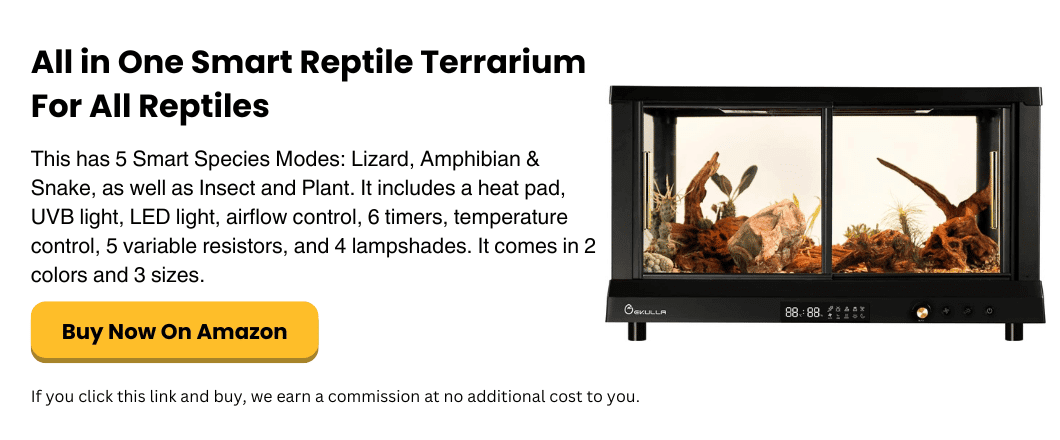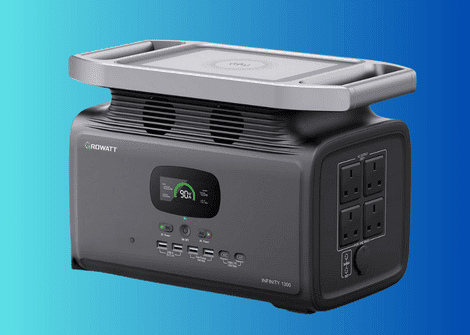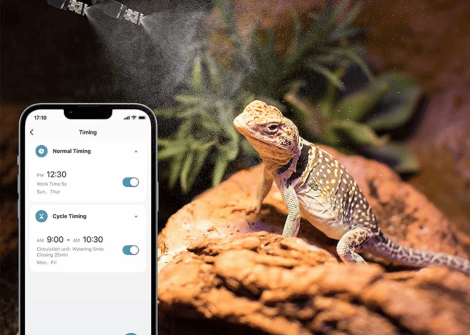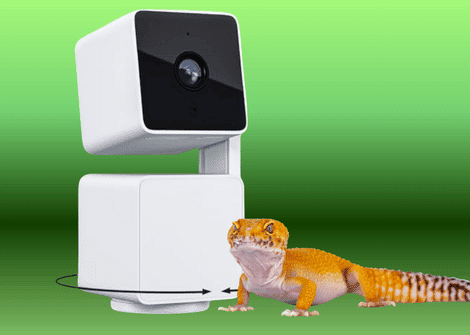Smart Terrarium Buying Guide: A Complete Guide for Reptile Owners
If you’re a new reptile owner, looking to purchase your first terrarium, or a reptile owner considering upgrading your pet’s habitat, all-in-one smart reptile enclosures represent the cutting edge of reptile care technology.
These innovative systems combine traditional terrarium design with modern automation, making it easier than ever to maintain optimal conditions for your reptiles, giving you more time to enjoy your pets.
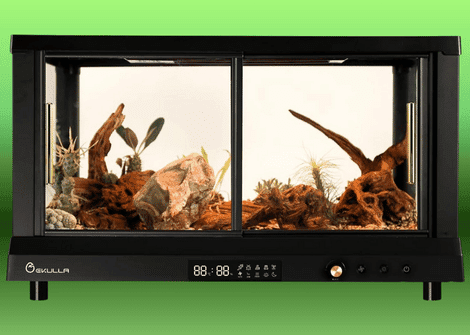
Table of Contents
What Are All-in-One Smart Terrariums?
Key Benefits Of Smart Terrarium Technology
Essential Features To Look For
Species-Specific Considerations
Installation and Setup
Maintenance and Long-Term Care
Cost Considerations and Value
Making Your Decision
Frequently Asked Questions
What Are All-in-One Smart Terrariums?
All-in-one smart terrariums are self-contained habitat systems that integrate multiple environmental controls into a single, automated unit. Unlike traditional setups that require separate heating elements, lighting systems, humidity controllers, and monitoring devices, smart terrariums consolidate these functions into one cohesive package. These systems typically feature built-in sensors, programmable controls, and smartphone connectivity, allowing you to monitor and adjust your reptile’s environment remotely.
The “smart” aspect comes from their ability to automatically maintain temperature, humidity, and lighting cycles based on your programming or preset species-specific profiles. Many models include features like automatic misting systems, temperature gradients, UV lighting schedules, and real-time environmental monitoring through mobile apps.
The primary advantage of smart terrariums lies in their consistency and convenience. Traditional reptile keeping requires constant vigilance and manual adjustments to maintain proper environmental conditions. Smart systems eliminate much of this guesswork by providing automated climate control that responds to real-time environmental changes.
These systems excel at creating precise temperature gradients, which are crucial for reptile health. Many species require specific basking spots alongside cooler retreat areas, and smart terrariums can maintain these variations automatically. The integrated monitoring capabilities also provide valuable data about your pet’s environment, helping you identify patterns and potential issues before they become serious problems.
For busy reptile owners, the convenience factor cannot be overstated. Whether you’re traveling for work or simply want peace of mind, knowing that your pet’s habitat is being monitored and maintained 24/7 provides tremendous reassurance. Many systems can send alerts to your phone if conditions fall outside acceptable parameters, allowing for quick intervention when necessary.
Essential Features to Look For
When shopping for a smart terrarium, several key features should guide your decision.
First, consider the quality and accuracy of the environmental sensors. Look for systems that monitor temperature, humidity, and light levels with precision, as even small variations can impact your reptile’s health.
Connectivity options are equally important. Most modern smart terrariums offer Wi-Fi connectivity and smartphone apps, but the quality and functionality of these apps vary significantly between manufacturers. Look for apps that provide real-time monitoring, historical data tracking, and easy control adjustments. Some premium systems also offer integration with smart home platforms like Amazon Alexa or Google Home.
The lighting system deserves special attention, particularly if you’re keeping species that require specific UV exposure. Quality smart terrariums should include full-spectrum LED lighting with programmable day/night cycles and seasonal variations. Some advanced models even simulate natural sunrise and sunset patterns, which can benefit your reptile’s circadian rhythms.
Heating elements should provide both ambient temperature control and focused basking areas. Look for systems that can maintain temperature gradients across the terrarium, allowing your pet to thermoregulate naturally. Safety features like automatic shut-offs and temperature limiters are also crucial for preventing dangerous overheating.
Species-Specific Considerations
Different reptile species have vastly different environmental requirements, and not all smart terrariums are suitable for every type of reptile. Before purchasing your smart terrarium, research your specific species’ needs regarding temperature ranges, humidity levels, UV requirements, and space considerations.
For desert species like bearded dragons or leopard geckos, look for systems that excel at maintaining lower humidity levels while providing strong basking spots and UV lighting. These reptiles typically require temperature gradients from around 75°F on the cool side to 100-110°F in basking areas.
Tropical species such as ball pythons or green tree pythons need systems capable of maintaining higher humidity levels (60-80%) while still providing proper temperature gradients. These systems should include reliable misting capabilities and humidity monitoring to prevent both dehydration and respiratory issues caused by excessive moisture.
Arboreal species require vertical space and multiple temperature zones at different heights. If you’re keeping tree-dwelling reptiles, ensure the smart terrarium provides adequate height and multiple monitoring points throughout the vertical space.
Installation and Setup
Setting up a smart terrarium typically involves more initial configuration than traditional habitats, but this upfront investment pays dividends in long-term convenience. Most systems require Wi-Fi setup and app installation before you can begin programming environmental parameters.
1. Choose the Right Location
Choose a stable, level surface away from direct sunlight, air conditioning vents, and high-traffic areas. Direct sunlight can interfere with temperature sensors and create dangerous hot spots, while drafts from HVAC systems can cause temperature fluctuations.
Ensure you have reliable Wi-Fi coverage in the chosen location, as connectivity is crucial for smart functionality. Clean the terrarium thoroughly with reptile-safe disinfectant before beginning setup.
2. System Installation and Calibration
Install all hardware components according to manufacturer specifications, paying special attention to sensor placement. Position temperature probes at both basking and cool zones, and place humidity sensors away from direct water sources to ensure accurate readings.
Download the companion app and complete the Wi-Fi setup process.
Run the system empty for 24-48 hours to establish baseline environmental readings and verify all components function correctly.
3. Substrate and Decor Setup
Add appropriate substrate for your species, maintaining proper depth for burrowing animals or drainage for high-humidity setups. Install hiding spots, climbing branches, and water features, ensuring they don’t obstruct sensors or airflow.
Arrange decorations to create natural temperature gradients, with basking areas directly under heat sources and cooler retreats in shadowed zones.
4. Programming and Testing
Configure species-specific parameters including temperature ranges, humidity levels, and lighting schedules. Start with manufacturer presets if available, then customize based on your research.
Test all automated functions including misting systems, lighting cycles, and heating elements. Verify that safety shut-offs work properly by briefly triggering temperature or humidity limits.
5. Final Monitoring and Adjustment
Before introducing your reptile, monitor the system for 3-5 days to ensure stable conditions. Use backup thermometers and hygrometers to verify sensor accuracy.
Make gradual adjustments as needed, allowing 24 hours between changes for the system to stabilize. Document successful settings for future reference and troubleshooting.
Maintenance and Long-Term Care
While smart terrariums reduce daily maintenance requirements, they still need some attention to function properly.
Sensor calibration should be checked monthly, as dust, humidity, and time can affect accuracy. Most systems include calibration procedures in their apps or instruction manuals.
The automated systems occasionally require maintenance. Misting nozzles can clog, heating elements may need replacement, and LED lights will eventually require updates. Establish a regular maintenance schedule that includes cleaning sensors, checking connections, and testing all automated functions.
Software updates are another important consideration. Like any connected device, smart terrariums benefit from firmware updates that improve functionality and fix bugs. Enable automatic updates when possible, or check regularly for available improvements.
Cost Considerations and Value
Smart terrariums represent a significant initial investment, typically costing 2-3 times more than equivalent traditional setups. However, when evaluating cost, consider the long-term value proposition.
These systems often reduce electricity costs through efficient LED lighting and precise temperature control. They also minimize the risk of costly veterinary bills resulting from environmental stress or illness.
The convenience factor also has value that’s difficult to quantify. For busy professionals or frequent travelers, the peace of mind and reduced daily maintenance requirements may justify the higher upfront cost. Additionally, the detailed environmental data these systems provide can help optimize your reptile’s health and longevity.
Making Your Decision
All-in-one smart terrariums represent an exciting advancement in reptile care technology, offering unprecedented control and monitoring capabilities. They’re particularly well-suited for dedicated reptile enthusiasts who want the best possible care for their pets and appreciate the convenience of automated systems.
However, they’re not necessary for successful reptile keeping, and traditional setups remain perfectly viable for most species. Consider your budget, technical comfort level, and long-term commitment to reptile keeping when making your decision.
If you choose to invest in smart terrarium technology, research thoroughly, choose a reputable manufacturer, and be prepared for a learning curve as you optimize the system for your specific needs.
Frequently Asked Questions
If you still have some questions about all-in-one smart terrariums, here are the most commonly asked FAQs, with answers. We hope they help!
Are Smart Terrariums Necessary For Proper Reptile Care?
No, smart terrariums aren’t essential for successful reptile keeping. Traditional setups with manual monitoring and adjustment work perfectly well for most species. However, smart terrariums offer significant advantages in terms of consistency, convenience, and detailed environmental tracking. They’re particularly beneficial for busy owners, those who travel frequently, or keepers managing multiple reptiles.
If you decide to stick with a traditional terrarium, though, you might find it easier to install a couple of smart terrarium accessories, which will make your life a lot easier! Accessories such as a smart mister system and smart lighting would be our minimum go-tos.
How much do all-in-one smart terrariums typically cost?
Complete smart terrarium systems generally range from $300-$1,500 depending on size and features. While this represents 2-3 times the cost of traditional setups, consider the long-term value including reduced electricity costs, prevention of health issues, and time savings. Many owners find the investment worthwhile for the peace of mind and improved care quality.
What happens if the Wi-fi goes down or the app stops working?
Most quality smart terrariums include fail-safe mechanisms that maintain basic functions even without connectivity. Heating, lighting, and other essential systems typically continue operating on their last programmed settings. However, you’ll lose remote monitoring and alert capabilities. It’s wise to check your terrarium manually during connectivity issues.
Can I use a smart terrarium for any type of reptile?
Generally, yes. Smart terrariums excel with species requiring stable, predictable environments like ball pythons, bearded dragons, and leopard geckos. They may be less appropriate for less-common reptiles with very specific microclimates or those requiring frequent environmental changes. Always research your specific reptile’s needs before purchasing.
How accurate are the sensors in smart terrariums?
Quality systems typically maintain accuracy within 1-2°F for temperature and 3-5% for humidity. However, sensors can drift over time and may be affected by dust or moisture. It’s recommended to calibrate sensors monthly and use backup monitoring devices to verify readings, especially during initial setup.
Do smart terrariums require a lot of maintenance?
Smart terrariums actually reduce daily maintenance compared to traditional setups, but they do require different types of upkeep.
Monthly tasks include sensor calibration, cleaning misting nozzles, and checking all automated functions. You’ll also need to perform software updates and monitor system performance. Overall maintenance time is typically less than traditional systems, but technical troubleshooting may occasionally be needed.
What should I look for in a smart terrarium app?
A good smart terrarium app should offer real-time monitoring, historical data tracking, customizable alerts, and easy parameter adjustments.
Look for apps with intuitive interfaces, reliable connectivity, and the ability to create species-specific profiles. Advanced features like data export, multiple terrarium management, and integration with smart home systems are valuable bonuses. Read recent app reviews before purchasing.
Are there any safety concerns with smart terrariums?
Like any electronic system, smart terrariums can malfunction, making safety features crucial. Look for systems with automatic shut-offs, temperature limiters, and fail-safe modes. Ensure heating elements are properly protected and can’t create dangerous hot spots. Regular maintenance and monitoring are essential, and having backup systems or manual overrides provides additional security for your reptile’s safety.
More Reading
Smart power backup systems automatically maintain critical heating and lighting during outages. They send smartphone alerts to keep you updated, and can keep terrariums running for hours or even days.
A smart misting system maintains the proper humidity level in your terrarium. It delivers the right moisture at the right time, helping your pet stay comfortable and healthy, But is it the right choice for you and your pet?
It’s not always an obvious choice for reptile owners, but a smart pet camera is a great and inexpensive way to monitor and enjoy your pet remotely. It also gives you peace of mind they’re ok when you’re not at home.

